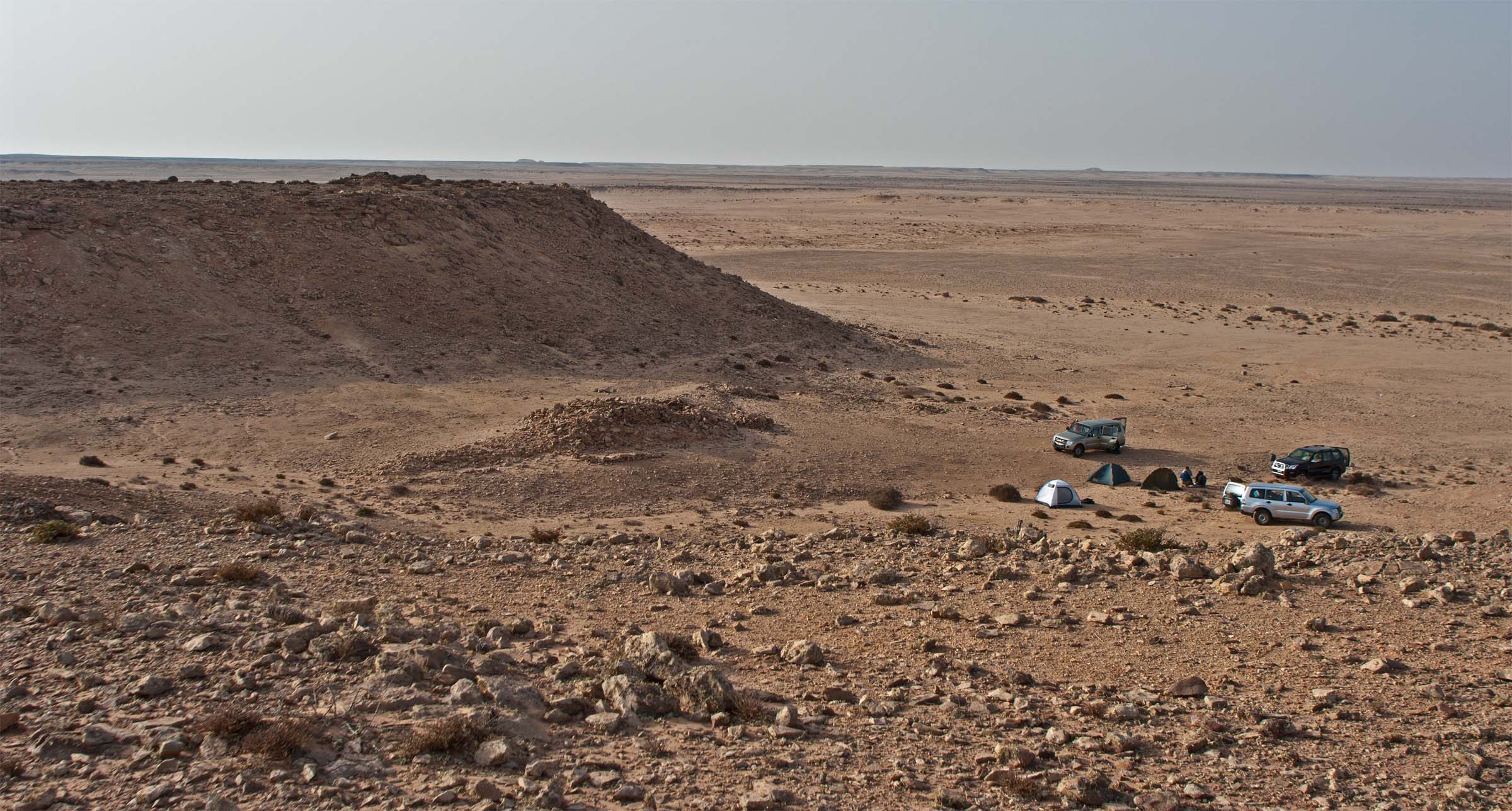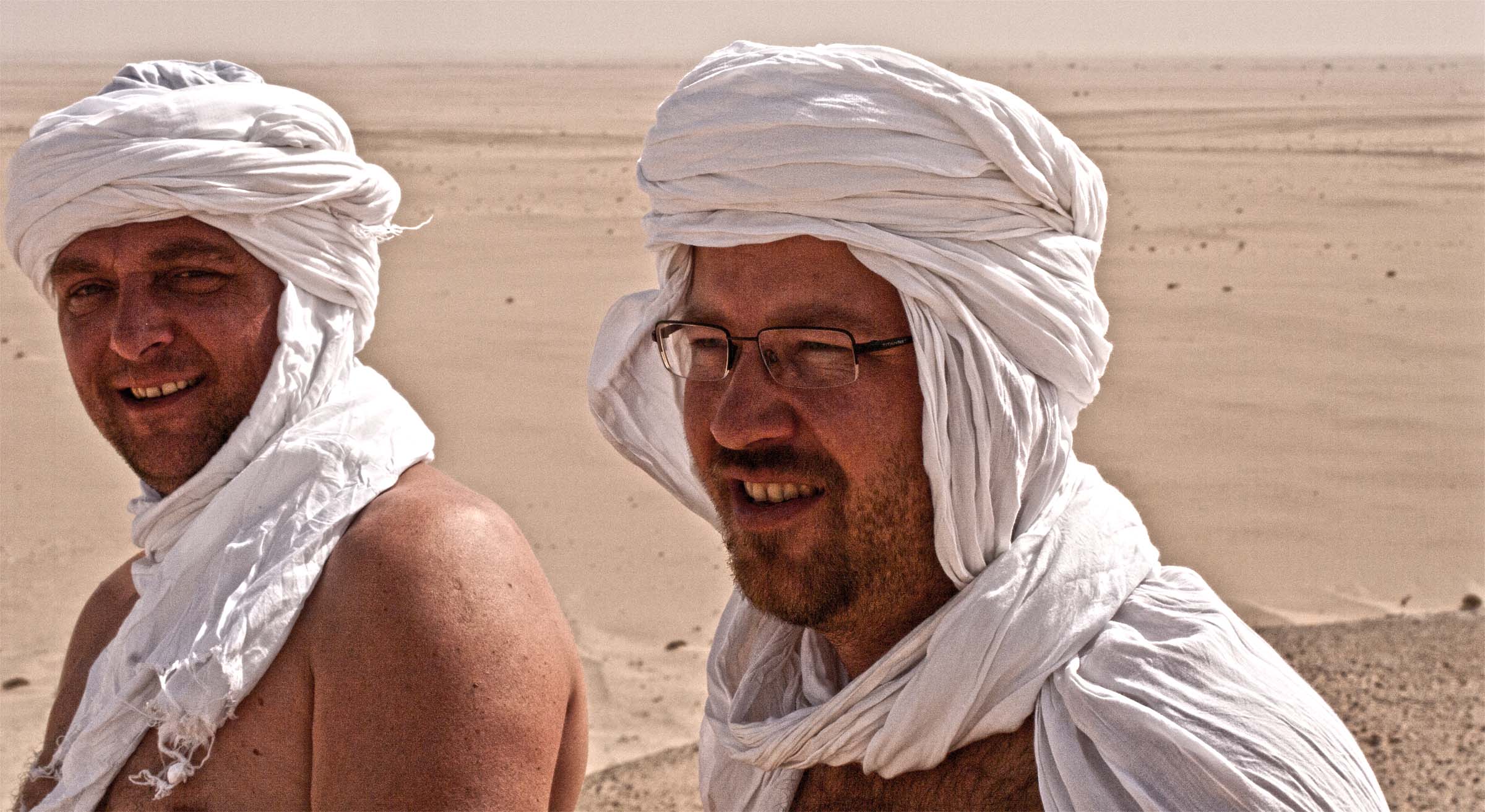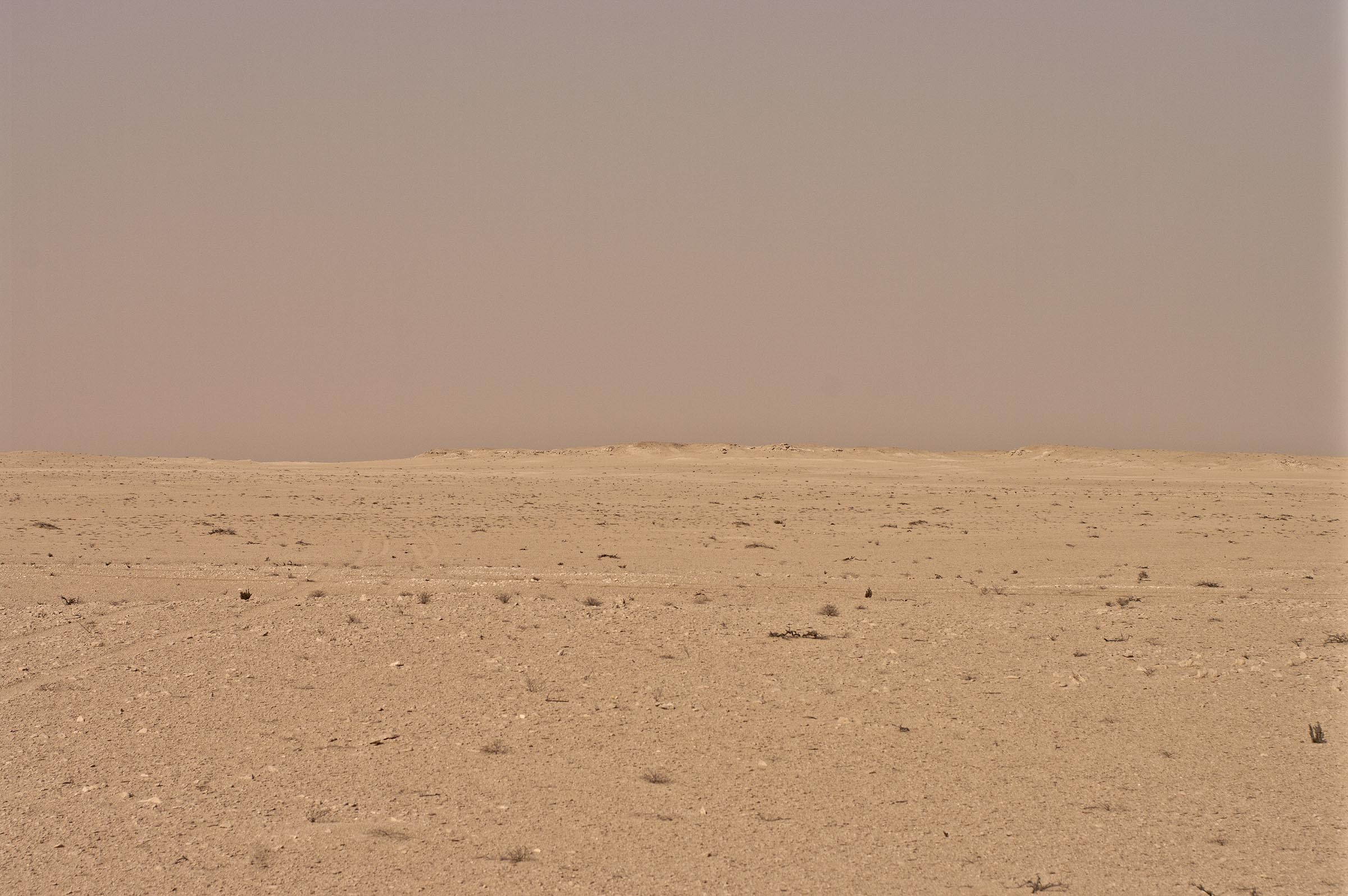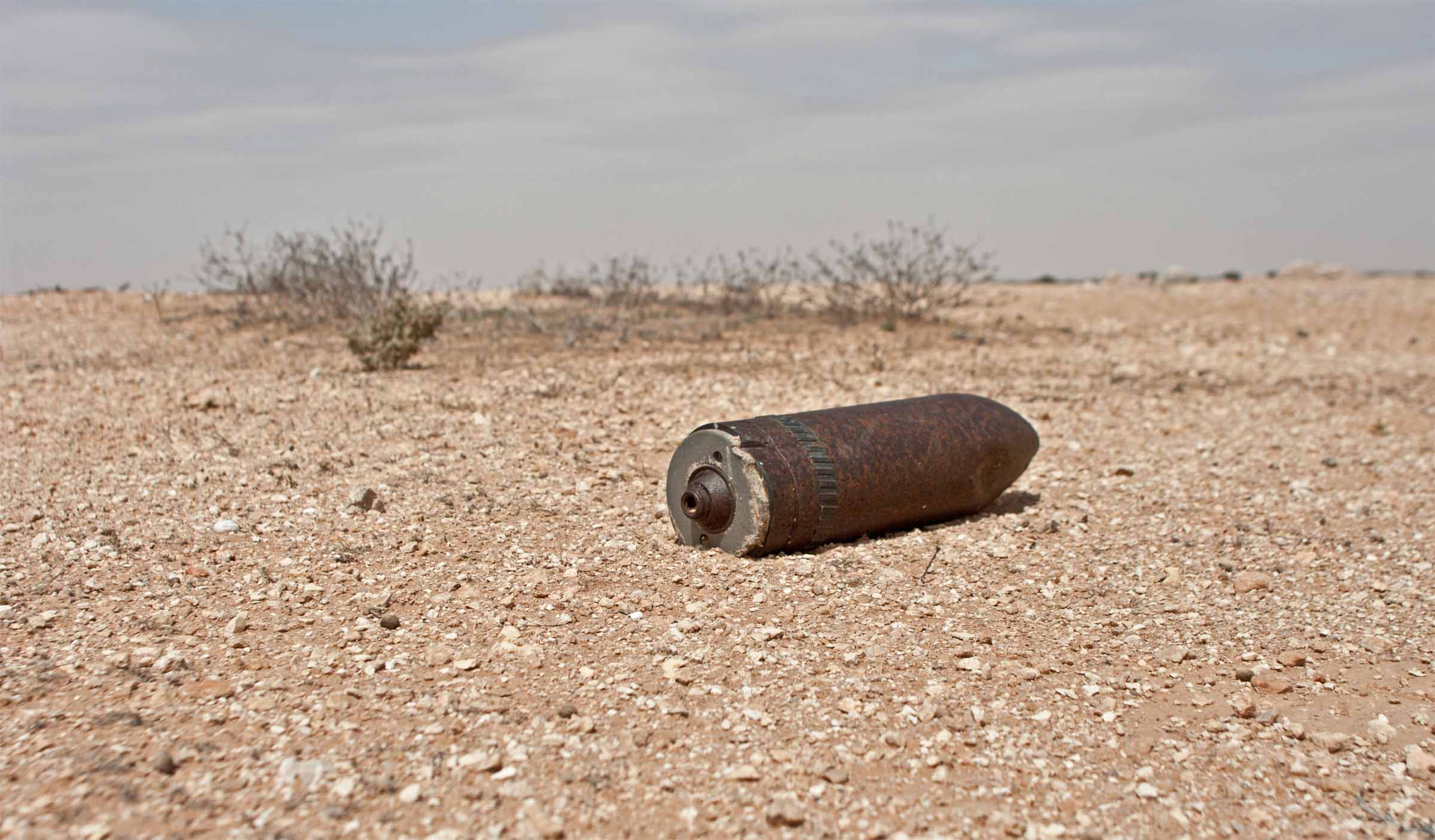As my co-pilot and for the third time my Moscow friend and advisor Pjotr Muromov accompanied me. Twenty years ago already, after the meager scientist salary which he had received from his ever broke governmental employer failed to appear for several months in a row, he had quit his job at one of the most prominent Moscow institutes. Henceforth he devoted his skills to commercial meteorite prospection. A profession he soon administered with expert mastery.
Contrary to the Russian cliché Pjotr showed none of the impulsiveness commonly attributed to his fellow countrymen. If one took the speed of a shifting sand dune with which he executed the daily routines as a criterion, one could easily get the idea that he spent most of the time in a state of semi-somnolent hibernation.
However, this was not the case. Instead Pjotr was rather a modern Lomonossov, constantly occupied to fathom nature’s phenomena by the use of appropriate instruments. If he was not metering, weighing or taking notes he was thinking about the implications of his observations. The fact that he took three thermometers to the desert (of which one is now dangling from an acacia branch in the Wadi Tighzert) may give an idea of the standards he demanded for exact observation.
To bridge the language barrier Pjotr tampered with a state of the art voice-translator. Over the day he noted down words and idioms which he later translated on occasion of our breaks into English. Even during our trip his language skills improved noticeably. Under his short trimmed pitch black hair sparkled a pair of shrewd steel blue eyes. Barely a thing escaped his sharp gaze. Also I suspected him to clandestinely study the works of Descartes, since hardly a day passed where Pjotr did not try to entangle me in bewildering discussions by methods of Subjective Dialectics. One didn’t quite know if that was out of a pure thirst for knowledge or plain entertainment for him.
The two Swiss Marc Jost and Roger Perrinjaquet manned our second car. The alpine team distinguished themselves by a deadpan sense of humor and indefatigable endurance. They beamed with confidence and one could rest assured to overcome any challenge with these guys. For the complete tour I cannot remember having heard them complain about anything whatsoever.
As a meteorite collector of the early days Marc was a profound expert on meteorite falls and finds from Northwest Africa. He shared a passion for meteorite searching which is hard to convey to an uninvolved observer. In his case one could rather speak of an almost pathologic addiction. An addiction which sometimes can be seen with natural borne mountaineers, who, in the face of a snow covered summit, feel an indomitable craving to conquer it in order to find fulfillment and peace of mind, if only for a short while.
As a further fortunate coincidence Marc possessed masterly skills in what can only be called sophisticated field cuisine. This had a direct and noticeable effect on the team’s morale. After I had pitched my tent and returned from a brief walk of the surroundings, Marc stood behind the gas cooker juggling with two frying pans with which he already had produced a stack of exquisite omelets. We didn’t need to be asked twice and opened the buffet right on the spot.
The Swiss expeditioneers. LTR: M. Jost, R. Perrinjaquet
Our Tuareg friends had parked their vehicles within sight on the flat plain. Contrary to western travelers the desert nomads always pitched their camps on the free windy plains, even if rocks or slopes providing shelter from the wind and sand were nearby. On previous occasions I had already observed this habit with the Tuareg of Libya, Algeria and Niger. When asking them why, I was offered various and little convincing, sometimes even contradictory arguments. One had to assume that the choice of these campsites did not rely on rational considerations but rather on a cultural atavism inherited from ancient times. From a time, when an unobstructed view was of vital importance to protect the clans from nasty surprises by wild animals or strangers with evil intentions.
In the light of a headlamp our new acquaintances were busy butchering and filleting the unlucky goat which Mohamed had traded in together with the meteorites. For the coming days this was to be our source of meat for the stew. Meanwhile we decided to make our supper perfect with a bottle Domaine du Sahari. This was a quite palatable red Gerrouane made of old Carignan-, Cinsault- and Grenache-varietals maturing on slopes at the foot of the Atlas Mountains where the Phoenicians already used to plant vineyards around 1000 BC.
Strengthened in such manner we undertook a little night search on the moonlit desert plain. On this occasion we collected dozens of shrapnel which were, however, not of cosmic origin. Besides a number of fierce, arm-sized bomb shrapnel we found plenty of jagged shell fragments of all calibers which bore witness to a heavy shelling of the location. The production stamp on the bottom of a 7.62 x 51 cartridge which was also found by us was dated to the year 1982.
As it turned out the following morning the mesa towering above our campsite was fortified with several Sangars. These were small field positions with breastworks of stone, built by the fighters instead of foxholes or trenches. The latter were impossible to dig here, given the outcropping bedrock which was covered only by a thin layer of dust and sand. We treated the Sangars with utmost caution. From the Dhofar and Sahara-Conflicts it was known that these positions, which were commonly used by the enemy as well, were often booby trapped by the retreating fighters.
Serir at noon, southern Saquia al Hamra, Ahmed Laroussi area
After a brief breakfast we said our goodbyes to Oussaid and his gang who prepared to return to the north. With the rising sun in our back we left our campsite westward instead. The first search day was supposed to familiarize us with the natural surface rocks of the area. But the familiarization proved difficult. The many variations of dark pebbles on the bright surface prevented a simple scanning of the desert floor from the driving car. Instead the eye had to focus the individual rocks in order to recognize a potential meteorite hidden among them. This kind of search demanded full concentration and was particularly tiring.
The abundant Pleistocene alluvial gravels were all more or less ablated by water transport. In addition they were coated with a dark patina and many showed fine weathering cracks, similar to those which can often be found on meteorites. Every minute one’s view caught a particularly malicious specimen which perfectly displayed the characteristic features of a weathered chondrite. The variety of different patterns on the respective types of gravel made a quick adaption nearly impossible. Soon doubts crept in, if a meteorite could be spotted on these surfaces at all.
From Ousaaid and his men we had learned, that the Moroccan nomads search the Hamadas for meteorites exclusively on foot. This may have had something to do with a lack of motorized transport, but in the face of plains as difficult as these, this also made direct sense. Both, Mohamed and Hassan as well as the Swiss team, made extensive use of this method. Often we could see them in the distance, hands fold on the back, head slightly lowered, slowly walking the desert pavement in the blurring haze.
From the viewpoint of statistics only the amount of the surface covered was decisive for success. Even with one’s search limited to the one to two meter wide strip close to the car, and despite the fact that our speed was only little more than walking pace, the area searched from the car in the course of a day was considerably larger than what could be covered by walking alone.
In fact we did search on the right spot. This was shown to us later during the day when we met a pair of Tuareg. Sitting in the shade of their Series II Land Rover, enjoying the obligatory Schai Al Ahtar, the green tea, the two were taking a rest in the desert. Subsequent to a warm welcome and extensive inquiries where we came from and where we were going, one of them, a short statured man with curious nickel spectacles, showed us a couple of trilobites from the Wadi Draa. To our surprise he had also a small meteorite of approximately 20 grams which he had stumbled upon a few days ago only an hour driving to the north.
105 mm HESH-shell (High-Explosive Squash Head). The dud is of similar type as the US M392A2, but due to absence of markings (typical feature of exported ordnance), country of origin and production date could not be determined
With thanks we declined his offer to sell us the meteorite. Our argument, we were here to find meteorites ourselves, was acknowledged with a cheerful laugh. We encouraged the finder, as we used to repeat mantra-like on similar occasions, to properly document find locations and find circumstances, and to forward this information together with the stone to the new owner in case the meteorite changes hands.
Our search continued. With the exception of a fearsome dud we came across nothing of particular interest. At the base of the 105 mm HESH-shell (High Explosive Squash Head) with base fuze and spent tracer, chisel marks told of a daredevil craftsman’s unsuccessful attempt to gather the main charge. At noon we headed for a shallow Qued where we sat in the shadow of an old umbrella acacia around a large plate with stew and potatoes.
When we arrived, under Mohamed’s close supervision Hassan was busy kneading a giant lump of dough, composed of flour, water and a pinch of salt, from which the famous Xubs al-Malla, or Lmilla, which is Tamashek for ash-bread, would be baked.
For this purpose Mohamed had prepared a fire on a smooth sand surface. After the fire had burned down, he brushed the embers aside with an acacia branch. Then he prepared a shallow pit in the sand almost a meter in diameter in which he placed the flat circular dough. Subsequently he carefully covered the dough with an even layer of sand on which he finally distributed the remaining embers again.
About an hour had passed when Mohamed took the acacia branch anew and brushed both, embers and sand aside, and pulled a crisp and tanned baked bread from the sand. A sweet fragrant scent spread across the camp. Then he tapped off the bread with the flat hand. The perfectly baked bread tasted excellent and like on previous occasions I was amazed that not a single grain of sand remained in the coarse crust of the Lmilla.
After our lunch Mohamed quite ingeniously organized himself a toothpick by picking a long thorn from a particularly spiny acacia branch with his teeth, without taking the slightest scratch.
We decided to leave our camp in place and made arrangements to search the wider surroundings of the Wadi. An hour before nightfall we would meet there again. Apart from finding a number of bifacial Neolithic artifacts flaked from brown silex which were spread on a beautiful bright limestone terrace approximately five kilometers southeast of our campsite, the afternoon went by without further unusual events. In the early evening dark rainclouds clustered in the eastern sky, but due to the prevailing northern winds they didn’t scare us much. As a measure of precaution though, I had our tents pitched not on the comfortable sandy bottom of the valley, but on the adjacent gravel terrace on its edge.
While searching a place for my tent I ran into Roger who was also scouting the edge of the Wadi for a suitable campsite. He walked with a slow pace and he was followed by his already assembled tent which the wind blew somersaulting after him. While this was already a curious picture in its own right, the really bizarre fact was that the tent by no means took a straight direction as one could have expected, but literally followed its owner patiently in his deviations to the left and to the right around the bushes, as if guided by a ghostly hand. When I approached him about this fact Roger matter of factly answered, “Yes, of course, the tent obeys today”.
Anyway Roger and his tent shared a most peculiar relationship. One must add that it was in no way an ordinary tent. This was a special and most sophisticated self-erecting construction, which, after releasing a built in mechanism, and similar to an umbrella, unfolded itself gracefully within seconds. At least that was how it was supposed to be. In practice though, faulty deployments occurred frequently, asking for complicated manoeuvers to fix the malfunction. Roger performed these under frequent threats to his uncooperative habitat. The latter caused Hassan to remark, that the strange structure obviously housed an evil Djin, one that had to be soothed by patient and recurring incantations.
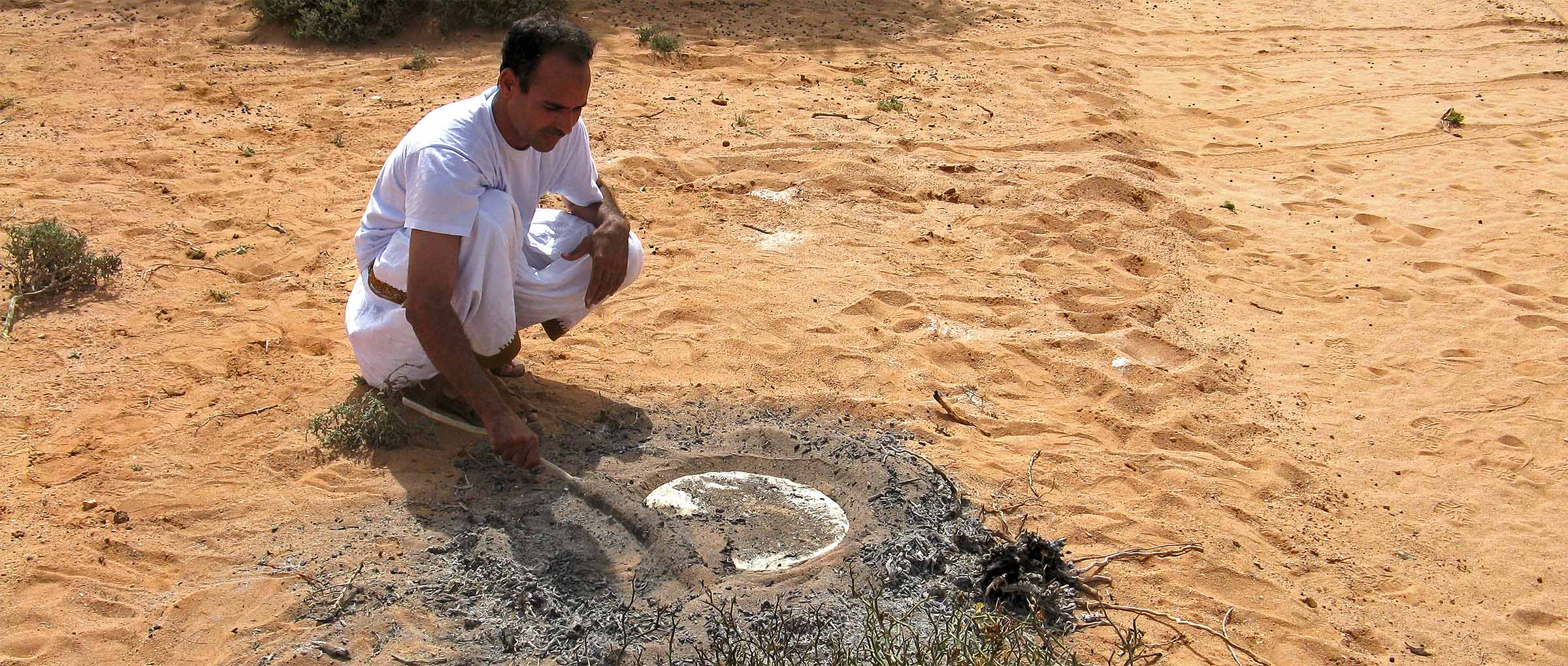
Mohamed recovering the Lmilla from the fire pit
At least for now the rain did not arrive and after an uneventful night we started out again. This time with the firm conviction that the first find would soon occur. But that was not to happen. Around noon, now at the northern sky, dark clouds gathered. Soon it became evident that we would not get away with it anew. Not even one and a half hour after the first signs a hot surge of red dust, the front wave of the storm, hit us. Instants later a cloudburst struck, on occasion of which we noticed that our wiper blades were down to the metal.
Almost blind we literally felt our way across the plain. Under these circumstances a meteorite search was unthinkable. The dried out substrata of the desert pavement was naturally not in a state to absorb such a downpour. Quickly, due to a lack of gradient, single puddles collected in the few depressions which soon connected into growing lakes. Eventually the complete landscape was threatened with submerging. Neither Pjotr nor I had ever experienced anything alike.
To wait out the end of the storm we headed for the safety of a shallow ridge which came into sight on the near horizon. On our way we spotted the Swiss team on a convergent course. Apparently they had come up with the same idea. An hour later all of a sudden the rain stopped and the first blue patches of sky appeared. Another hour later hardly a trace of moisture was left on the ground. Only the temperature remained pleasantly chilly for the rest of the day
On closer inspection though, one could see clearly that the micro-texture of the surface had changed. The drain off had washed out small rocks and the fine gravel was framed with little rivulets. In some places the retreating water had left delicate asymmetric ripple marks in the sediment – proof of a weak flow on the slight gradient.
For potential meteorites embedded in the surface sediments nothing good could be expected from such a torrential downpour. Small fragments were in danger of being transported away from their sites of impact by the flowing water. Even if it ammounts to were only a few millimeters each time this happens, the distances will eventually accumulate over the millennia since the time they fell. It was obvious that single fragments could be moved over greater distances. The washout had the additional effect that the meteorites sank deeper within the sediment layers.
In the long run two forces worked against this. First, the steady wind erosion which uncovered the meteorites by taking away the fine-grained surface material. And secondly, the upward movement of compact debris within the sediment layers. A process caused by the swelling of clay minerals following the rare periods of ground fog, after which moisture creeps into the top soil. It remained questionable though, if the effect of these two forces was sufficient to compensate the effect of the rainfalls during the climatic cycle of the year.
As for the question of chemical weathering in our opinion the present average annual rainfall of 50 mm was negligible. The short duration of the rains, a quickly restored low humidity and a high degree of evaporation reduce the oxidation-supporting effect of the rains to a rather short duration. However, Paleoclimatic data for the region are patchy and variations within the last 3,000 years and beyond are likely.
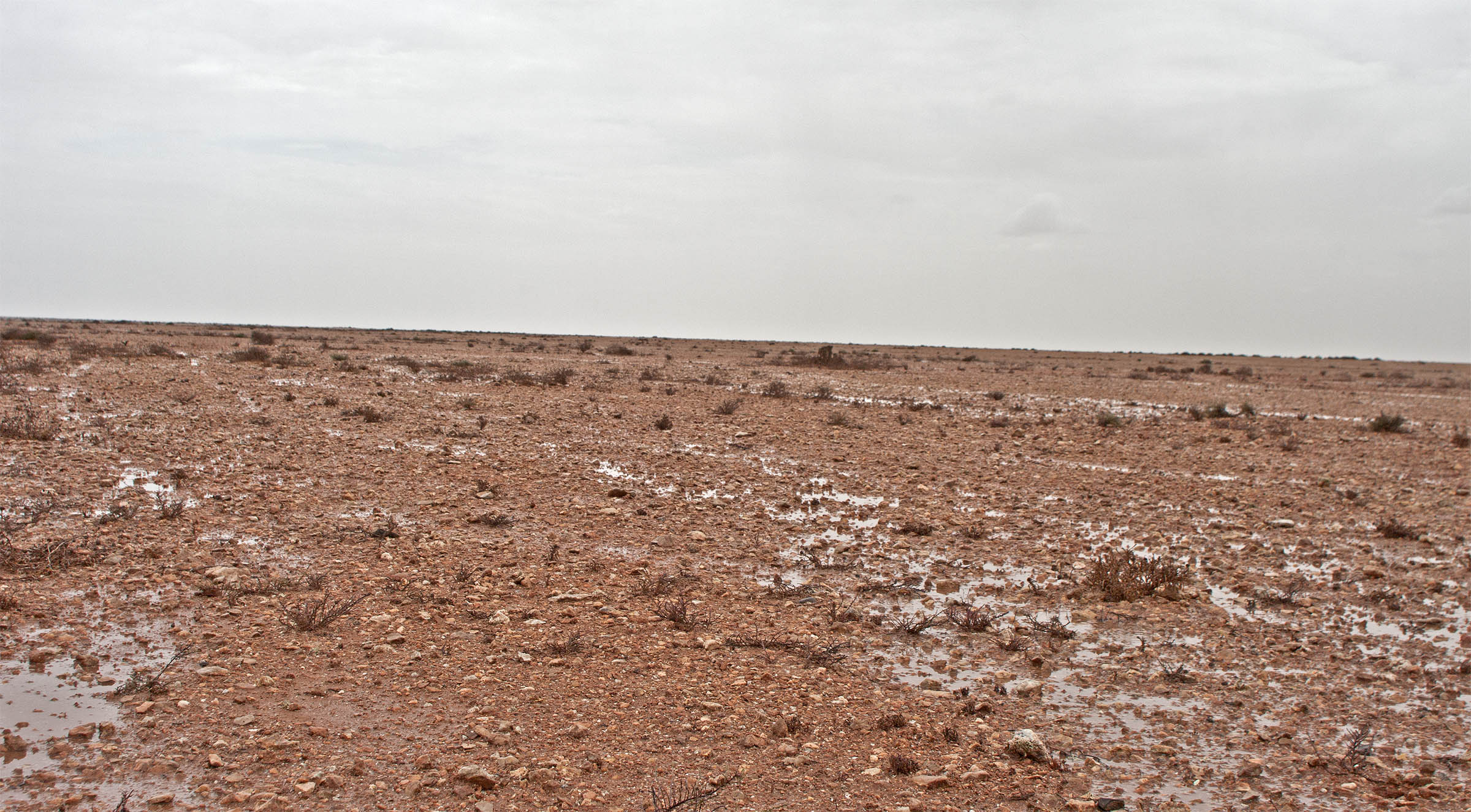
After the rains, Al Gada, September 21, 2010
As darkness settled we built our camp at the edge of a Wadi several kilometers to the west. No trace of recent rainfalls could be found at the spot. As could be expected, the rains in the Al Gada fell not extensively over wide areas but were locally limited.
Long after nightfall, the pale moon had already risen above the horizon, a pair of headlights approached in the distance. Because our small fire was set up in a hollow, we were convinced that our camp could not be seen. Therefore we wondered who was undertaking joyrides through the countryside in the middle of the night. After a while the vehicle passed our position, returned in a wide circle across the higher plateau, and after a brief stop at the edge of the slope it moved away into the direction it had come from.



